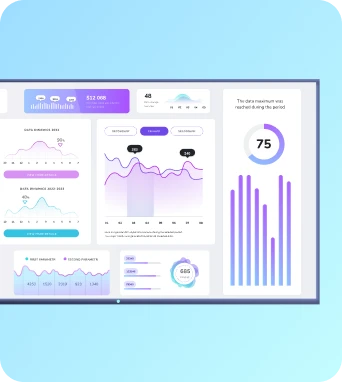Ambilight effects
Ambilight effects are dynamic ambient lighting techniques that extend on-screen visuals into the surrounding environment by sampling or analysing content and driving LED or display lighting. In digital signage they boost perceived contrast and brand presence, reduce eye strain, and create immersive dashboards and workplace displays that react to scheduled or live content.
What is Ambilight effects?
Colour sampling, mapping and player synchronisation
Ambilight implementations begin with how content is sampled and translated into control signals. Typical sampling strategies include edge sampling, region averaging and weighted sampling where, for example, the bottom 20 percent of a frame may be analysed to derive an average hue for a lower bezel strip, while corners are sampled independently for side panels. Colour space and gamma correction matter: signage content rendered in sRGB or Rec.709 must be linearised before averaging to avoid perceptual bias. In practice this means player software performs a conversion, computes a histogram or dominant colour cluster, then maps results to the device colour profile so LEDs reproduce the intended tones without oversaturation. Mapping logic often includes smoothing, rate limiting and brightness scaling to prevent rapid flicker when scenes change. A common approach is to apply an exponential moving average on sampled values and cap maximum PWM values for LED controllers. Hardware interfaces vary: networked controllers using MQTT or REST endpoints, SPI-based LED strips controlled by Raspberry Pi or commercial players, and HDMI capture devices that offload processing to a GPU. For example, a Raspberry Pi running a Fugo-compatible agent can sample frames at 15–30 fps, compute per-edge averages and issue SPI transfers to APA102 or WS2812 controllers; alternatively, enterprise players may expose a REST API that Fugo.ai calls to push per-frame palettes for synchronised rooms. Synchronisation across multiple displays requires time alignment and a shared clock or timestamped frame buffers. In multi-panel dashboards, players should agree on a sampling interval and a sequence number so that peripheral lighting follows the same frame. This is particularly important for video walls or meeting-room setups where misaligned Ambilight leads to distracting artefacts. For signage networks, centralised configuration, OTA updates and logging of sample rates and latency help operators diagnose issues where hardware throughput, network jitter or CPU contention degrade synchronisation and perceptual continuity.
Deployment, monitoring and optimisation of Ambilight effects
Deploying Ambilight in real-world signage estates involves hardware selection, calibration and operational safeguards. Begin by specifying LED density and controller type to match viewing distance and display size; higher density yields smoother gradients but increases processing and power requirements. Power planning must account for peak current draw, and installation teams should separate LED power rails from player power to avoid brownouts. Calibration is a practical step: run automated colour calibration sequences from the player to tune gamma and white balance for the installed LED strips or backlight panels so that ambient tones match the on-screen reference under typical room lighting. Monitoring and optimisation are continuous tasks. Operators should instrument players and controllers to report metrics such as sample rate, control latency, CPU/GPU utilisation and power consumption; these telemetry points reveal where lag or frame drops originate. Common pitfalls include overloading a low-power player with both content decoding and high-frequency LED updates, or using aggressive smoothing that masks quick data changes on dashboards. Fugo.ai and similar platforms support staged rollouts and per-device configuration, so you can disable Ambilight on constrained endpoints, set lower sample rates for static information displays, or schedule intensity limits during night hours. Use fallbacks: if the sampling pipeline reports errors, revert to a neutral ambient colour or a brand-safe static palette to avoid distracting viewers. Optimisation also touches content creation and automation. Designers can author media with bleed-safe edges and avoid extreme flicker-prone sequences for screens that will drive ambient lighting. For dashboards, set thresholds so that alerts drive distinct lighting states rather than raw pixel samples, enabling meaningful attention signals without constant colour churn. Finally, establish a maintenance routine: check LED integrity, verify firmware versions on controllers, and review logs in Fugo.ai for anomalies. A well-monitored Ambilight deployment will feel seamless to viewers and scalable for administrators managing hundreds of endpoints.
Final Thoughts on Ambilight effects
Keep the learning going...
Amazon Fire TV Stick
An Amazon Fire TV Stick is a compact consumer streaming player that can run signage apps and act as a low-cost digital signage player. In signage contexts it connects to content platforms like Fugo.ai, rendering playlists, dashboards and interactive content over HDMI while relying on Wi-Fi, Fire OS and app-based management for remote updates and control.
Ambient light sensors
Ambient light sensors are hardware devices or integrated system sensors that detect environmental illumination and report lux or correlated colour temperature values. In digital signage contexts they enable automatic brightness and colour adjustments, reduce power consumption, and maintain consistent visual quality across diverse locations and viewing conditions.
Android digital signage player
An Android digital signage player is an Android device or dedicated application that delivers scheduled multimedia playlists, HTML5 dashboards and data-driven layouts to TV and workplace displays. It connects to cloud platforms such as Fugo.ai for remote provisioning, content updates, reporting and integration with calendars, APIs and business intelligence feeds to automate screen content.



